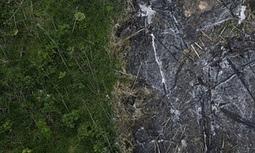 Deforestation
Deforestation
Lucy Siegle: “Peak deforestation angst didn’t actually coincide with peak deforestation. While the wearing of “Save the Rainforest” T-shirts was de rigueur in the late 80s, the worst destruction came in 2004, a year when we (as in humankind) chopped down 27,000km2 of Amazon rainforest. By that point there wasn’t much left to play with: the Brazilian Amazon region (the largest continuous tropical rainforest in the world) had shrunk from four million kilometres (close to half the size of continental Europe) to just 18% of that size.
“Brazil is still home to 40% of global rainforest, despite so much of it being destroyed to supply a range of products from toothpaste and face creams (tallow from cattle) to leather for football boots. It was in the 80s that agronomists first recognised that agricultural markets were behind runaway deforestation. In 2009, the Greenpeace report Slaughter of the Amazon showed the international leather and beef trades as the primary drivers of deforestation in the region.” Sourced through Scoop.it from: www.theguardian.com
Deforestation and Human Population
GR: Deforestation continues. As long as the human population grows, the destruction of natural vegetation is inevitable. This article describes some of the steps that can mitigate the impacts. A glance at the Groene Woud photo will tell you that the mitigation is no substitute for native vegetation. I’ve even seen arguments that the replacement of native vegetation with human-built environments isn’t such a disaster, because cities themselves provide habitat for wild animals. That’s true, but the habitat is not the one that fits the adaptations of most of the species of a region. Native plants and plant communities support native animals that, in turn, thin, pollinate, and connect native plants. From experience, I can report that the vegetation of cities, roadsides, and power transmission corridors are composed primarily of nonnative species. Replacing natural plant communities with urban plant communities reduces biodiversity and productivity.
 Deforestation
Deforestation
